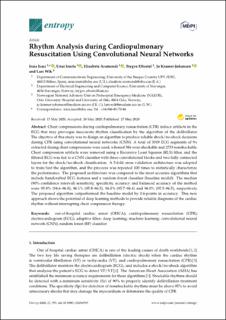| dc.contributor.author | Isasi, Iraia | |
| dc.contributor.author | Irusta, Unai | |
| dc.contributor.author | Aramendi, Elisabete | |
| dc.contributor.author | Eftestøl, Trygve Christian | |
| dc.contributor.author | Kramer-Johansen, Jo | |
| dc.contributor.author | Wik, Lars | |
| dc.date.accessioned | 2021-04-08T09:23:41Z | |
| dc.date.available | 2021-04-08T09:23:41Z | |
| dc.date.created | 2020-10-06T13:05:53Z | |
| dc.date.issued | 2020-05 | |
| dc.identifier.citation | Iasi, I., Irusta, U., Aramendi, E. et al. (2020) Rhythm Analysis during Cardiopulmonary Resuscitation Using Convolutional Neural Networks, Entropy. 2020, 22 (6), 595. | en_US |
| dc.identifier.issn | 1099-4300 | |
| dc.identifier.uri | https://hdl.handle.net/11250/2736811 | |
| dc.description.abstract | Chest compressions during cardiopulmonary resuscitation (CPR) induce artifacts in the ECG that may provoque inaccurate rhythm classification by the algorithm of the defibrillator. The objective of this study was to design an algorithm to produce reliable shock/no-shock decisions during CPR using convolutional neural networks (CNN). A total of 3319 ECG segments of 9 s extracted during chest compressions were used, whereof 586 were shockable and 2733 nonshockable. Chest compression artifacts were removed using a Recursive Least Squares (RLS) filter, and the filtered ECG was fed to a CNN classifier with three convolutional blocks and two fully connected layers for the shock/no-shock classification. A 5-fold cross validation architecture was adopted to train/test the algorithm, and the proccess was repeated 100 times to statistically characterize the performance. The proposed architecture was compared to the most accurate algorithms that include handcrafted ECG features and a random forest classifier (baseline model). The median (90% confidence interval) sensitivity, specificity, accuracy and balanced accuracy of the method were 95.8% (94.6–96.8), 96.1% (95.8–96.5), 96.1% (95.7–96.4) and 96.0% (95.5–96.5), respectively. The proposed algorithm outperformed the baseline model by 0.6-points in accuracy. This new approach shows the potential of deep learning methods to provide reliable diagnosis of the cardiac rhythm without interrupting chest compression therapy. | en_US |
| dc.language.iso | eng | en_US |
| dc.publisher | MDPI | en_US |
| dc.rights | Navngivelse 4.0 Internasjonal | * |
| dc.rights.uri | http://creativecommons.org/licenses/by/4.0/deed.no | * |
| dc.subject | hjerte-lunge-redning | en_US |
| dc.subject | hjerte- og lungeredning | en_US |
| dc.subject | HLR | en_US |
| dc.subject | ECG | en_US |
| dc.subject | CNN | en_US |
| dc.title | Rhythm Analysis during Cardiopulmonary Resuscitation Using Convolutional Neural Networks | en_US |
| dc.type | Peer reviewed | en_US |
| dc.type | Journal article | en_US |
| dc.description.version | publishedVersion | en_US |
| dc.rights.holder | © by the authors 2020 | en_US |
| dc.subject.nsi | VDP::Teknologi: 500::Medisinsk teknologi: 620 | en_US |
| dc.source.pagenumber | 17 | en_US |
| dc.source.volume | 22 | en_US |
| dc.source.journal | Entropy | en_US |
| dc.source.issue | 6 | en_US |
| dc.identifier.doi | 10.3390/e22060595 | |
| dc.identifier.cristin | 1837601 | |
| dc.source.articlenumber | 595 | en_US |
| cristin.ispublished | true | |
| cristin.fulltext | original | |
| cristin.qualitycode | 1 | |

